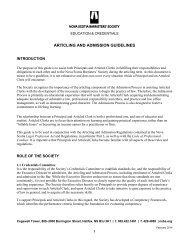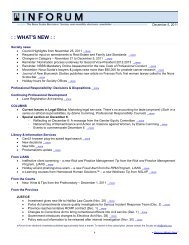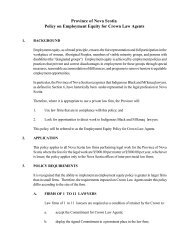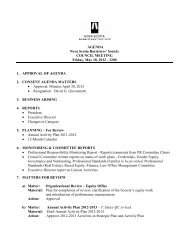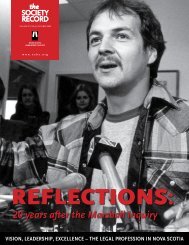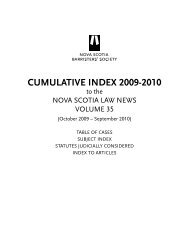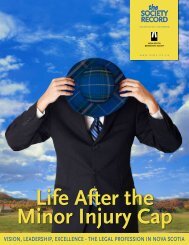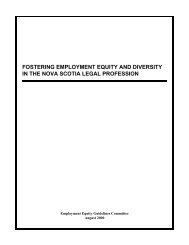SR Vol 25 No 1, January 2007 - Nova Scotia Barristers' Society
SR Vol 25 No 1, January 2007 - Nova Scotia Barristers' Society
SR Vol 25 No 1, January 2007 - Nova Scotia Barristers' Society
Create successful ePaper yourself
Turn your PDF publications into a flip-book with our unique Google optimized e-Paper software.
Justice Warner stated at paragraph 27 in Kemp v. Prescesky [2006]N.S.J. <strong>No</strong>. 174 (NSSC):With the increase in the monetary jurisdiction of the court is aconcomitant requirement for rules that protect the integrity andfairness of the court.I believe that encouraging pre-trial disclosure, and making theSmall Claims Court a court of record must occur to fulfill thisrequirement.Dealing with lay-litigants on the issue of pre-hearing disclosure isoften difficult. On occasion, I have proposed the mutual exchangeof documents but was met with suspicion when the individualfailed to appreciate that my motives were simply to expedite andsimplify matters. However, we could impede access to the courtsby discouraging impecunious lay-litigants from bringing theirclaim because of fear of court process or procedure, particularly iftheir opponent is represented by a lawyer and is demanding strictcompliance with the rules. That said, I believe it to be in the interestsof justice and expediency to encourage pre-trial disclosure.I believe recording proceedings is critical. A record will give clarity onappeals and provide accuracy to all involved, including the adjudicators.the more people who can get into court quickly and cheaply for aresolution. I would disagree.Take this example: With the advent of property condition disclosurestatements, many cases in Small Claims Court deal with unhappynew homeowners who discover the dream home they just bought hasa few nightmares. The purchaser argues the vendor knew or oughtto have known about the defects. The vendor says they had no idea,or the defects were obvious, or they aren’t all that serious. The resultis the price the vendor agrees upon may not be the final amount,perhaps by as much as $<strong>25</strong>,000. Did the vendor know that prior toagreeing upon a price?Should general damages be increased from their current $100?If not, why?One quirk of the Small Claims Court system is the cap on generaldamages of $100. So why have it at all? Or, if adjudicators can betrusted to deal with $<strong>25</strong>,000 claims, then are they not also ableto determine general damage awards to, say, $2,500? That wouldcertainly speed up the personal injury system with our broaddefinition of minor injury, and take the negotiating out of the handsof insurance adjusters.Another oddity of the system that government should reconsider isawarding costs. In Small Claims Court, there are none. For a $<strong>25</strong>,000case, it’s likely worth it to retain lawyers. Shouldn’t the successful partybe entitled to something for costs? If the government is worried aboutlawyers claiming excessive costs in a simplified court system, cap costsat, say, $500. Adjudicators already serve as taxing masters, and theyare lawyers, so they know what legal bills look like, and how muchwork goes into preparing for a trial, no matter what court it is.Do you feel, since the stakes are now much higher ($<strong>25</strong>,000, asJustice Warner recently stated, is more than the average <strong>No</strong>va<strong>Scotia</strong>n makes in a year), that there should be greater proceduralrules, including pre-hearing disclosure of documents and recordingof hearing?Justice Warner, in Kemp v. Prescesky, 2006 NSSC 122, has recognizedthat a $<strong>25</strong>,000 judgment is enough to bankrupt most <strong>No</strong>va <strong>Scotia</strong>ns.He has suggested a broader appellate approach when asking if therequirements of natural justice have been met. In my opinion, he’scorrect.Has SCC, with the new ceilingof $<strong>25</strong>,000, gotten too farDonald UrquhartMuttart Tufts Dewolfe & Coyleaway from its original intention?Has this become an accessto justice issue, since it’s the only forum for lay litigants?Small Claims Court – I consider it the wild wild west of the judicialsystem. With few rules and unrepresented parties, anything canhappen. And with the April 2005 amendment upping the limit to$<strong>25</strong>,000, the stakes are high.Procedure? In Small Claims Court there is no tape recording, so notranscript is available. There are only three grounds of appeal in thelegislation. If you represent the loser of a $<strong>25</strong>,000 claim, the only“record” for the appeal judge is a written decision of the adjudicator,who prepares it after learning an appeal has been filed. Maybe thisinformal approach was okay when the limits on liability were only afew thousand dollars and the tradeoff was a speedy resolution. But for$<strong>25</strong>,000, most lawyers would probably want a few more proceduralsafeguards, like formal exchanges of relevant documents, to protecttheir clients.Is bigger really better? The provincial government seems to thinkso. But what about the litigants? Avocates of a $<strong>25</strong>,000 limit willprobably say it’s an access to justice issue. The higher the limit,<strong>January</strong> <strong>2007</strong> 17



